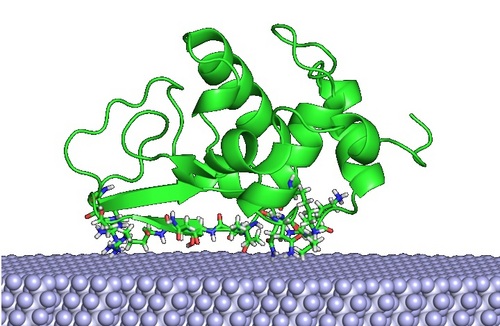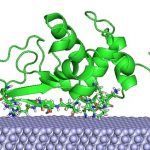 The 3D protein-surface structures of Lysozyme on the surface of PTFE
The 3D protein-surface structures of Lysozyme on the surface of PTFE
The University of Macau (UM) has achieved a breakthrough in the research of biochips. The Computational Biology and Bioinformatics Lab (CBBio), under UM’s Faculty of Science and Technology, and the State-Key Laboratory of Analog and Mixed-Signal VLSI, have successfully developed a computational intelligence-based software programme to address the challenges of conformational sampling in 3D protein-surface structure prediction, which helps to produce biochips with the ability to locate the optimal protein configuration in the most promising low-energy region. The work was recently published by Oxford University Press’s journal Bioinformatics, the most authoritative publication in the field of bioinformatics and computational biology. In order to predict the optimal protein configuration computationally, the research team translated the problem into an optimisation task, to search intelligently among all possible orientations and positions of protein with respect to the surface, for the most promising low-energy region where the optimal is. Inspired by nature, the ‘intelligent’ part of the project is based on the social behaviour model of bird flocking when searching for food. Birds in a flock would memorise places where the most food has been found, and communicate with one another to update the best food source. Based on this knowledge, the birds iteratively adjust their flying direction towards previously successful regions until no better food source is found. By combining the search model with a newly devised forcefield-based energy function describing the protein-surface interactions and fine-tuned parameters, the research team has created an efficient computer algorithm to address the protein-surface structure prediction problem, ProtPOS. The programme (http://cbbio.cis.umac.mo/software/protpos/) can work seamlessly with most popular molecular simulation software, so prediction results can be used right away in further computational studies for biochip design. The research project was conducted by UM PhD student Nga Choi Fong, jointly supervised by Dr Shirley Siu Weng In and Prof Elvis Mak Pui In, and funded by UM.


